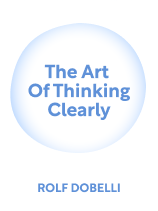

This article is an excerpt from the Shortform book guide to "The Art of Thinking Clearly" by Rolf Dobelli. Shortform has the world's best summaries and analyses of books you should be reading.
Like this article? Sign up for a free trial here .
What is the neglect of probability bias? Do you consider the probabilities of possible outcomes when making decisions?
Neglect of probability bias is the tendency to disregard probability or risk when making decisions in the face of uncertainty. The most optimal choice is the one that has the highest probability of turning out well, but people tend to opt for the option that will have the biggest positive impact if it occurs, regardless of how likely it is.
Here’s why we tend to neglect probability when making decisions.
Neglect of Probability
According to Dobelli, people struggle to make good decisions because they neglect to consider the probability or risk involved in those decisions. Logically, they should choose the option with the highest probability of going well for them and the lowest risk of going badly. However, people instead choose the option that will have the biggest positive impact on them if it occurs, regardless of how likely it is to occur. For example, Dobelli argues that people are more likely to invest in a risky stock that could have a huge return on investment than a safe stock that has lower returns.
(Shortform note: Dobelli claims that investors frequently invest solely based on the possible yield of an investment, rather than its risk, and uses this example to prove the validity of his claims regarding neglect of probability. However, this example isn’t accurate: Investors use various risk management strategies when investing, including analyzing the historical value of the stock to determine the risk of its value changing in the future.)
| Denominator Neglect A type of neglect that Dobelli doesn’t cover is denominator neglect, which Daniel Kahneman describes in Thinking, Fast and Slow. If the probability is a fraction, with the situation you’re evaluating on top and the total number of possibilities on the bottom, people base their judgment of risk solely on the top number, or numerator, and ignore the bottom number, or denominator. This means they regularly misinterpret probability, since the numerator depends on the denominator. For example, if you only considered the numerators when comparing a 1/100 chance of injury and a 100/10,000 chance of injury, you’d misinterpret the second scenario as much more likely to occur, even though the probability of injury is actually the same. |

———End of Preview———
Like what you just read? Read the rest of the world's best book summary and analysis of Rolf Dobelli's "The Art of Thinking Clearly" at Shortform .
Here's what you'll find in our full The Art of Thinking Clearly summary :
- A detailed look at the most common logical fallacies that inhibit decision-making
- How to recognize and overcome these fallacies to make better decisions
- Why you value things for arbitrary reasons






